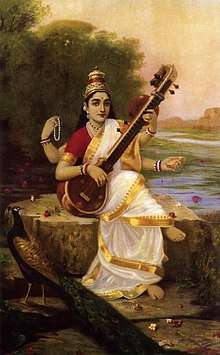Haveli Sangeet
Haveli Sangeet is an ancient classical form of Hindustani classical music sung in havelis.[1][2][3][4] The essential component is dhrupad. It originated in Mathura (Braj), Uttar Pradesh in North India. It is the great divine devotional song sung daily to the worship of Lord Krishna of Pushtimarg sect.
Under the survey of All India Radio, Govt of India it was realised by learned surveyors that the bandish, khayal sung in various gharanas of Hindustani classical music are derived from Haveli Sangeet where they are sung in compete and original form.
Some notable Haveli Sangeet vocalists are:
- Vitthalanatha (c. 1516-1588)
- Harirayji Maharaphu
- Gokulotsavji Maharaj
History
Havelis were places where Hindu deities were installed; due to restrictions on Hindu temples during the Muslim rulers, it was called Haveli Sangeet.
Basically, Haveli Sangeet is another name for Hindu temple music practiced by the followers of Vaishnavism of Nathdwara in Rajasthan, Gujarat, India, and considered a part of a rich historical tradition. Having its origin in Rajasthan and Gujarat, the Haveli music is believed to have an edge over dhrupad (the core of Indian classical music) for the common belief that the music has none other than Lord Krishna himself for an audience. Essentially a tribute to Krishna, its form includes devotional renditions like kirtans, bhajans and bhava nritya, all related to religious cult worship. Although a mix of classical and folk music, the style is inherently borrowed from the dhrupad and dhamar. Haveli Sangeet is commonly played at the many temples of India, like the Radha Vallabh of Vrindaban, Krishna of Nandgaon, Uttar Pradesh and Sri Nathji of Nathdwara, to name a few.[5]
With the passage of time, the Haveli Sangeet lost its popularity in India and is no longer in practice, as the general audience tends to take it for granted that all Haveli music simply falls under the devotional genre.[5]
In Gujarat, one school of thought holds that Indian classical music has its origins in the Haveli Sangeet of Vallabha Acharya, a pioneer in this genre.[6] The history of Indian classical music has it that the Vaishnavites of Nathdwara were the ones to uphold this sect founded by Vallabh Acharya.[1]
References
- "The Story of Hindustani Classical Music". ITC Sangeet research Academy. Retrieved 15 June 2013.
- Rajan, Anjana (September 3, 2009). "Song of the oarsman" – via www.thehindu.com.
- Sinha, Manjari (August 27, 2009). "The cadence of melody" – via www.thehindu.com.
- "Song of the oarsman". September 4, 2009 – via www.thehindu.com.
- "Dhrupad and Haveli Sangeet". Indian raga. Retrieved 15 June 2013.
- "Gujarat and Indian Music". Gujarat online. Retrieved 15 June 2013.
